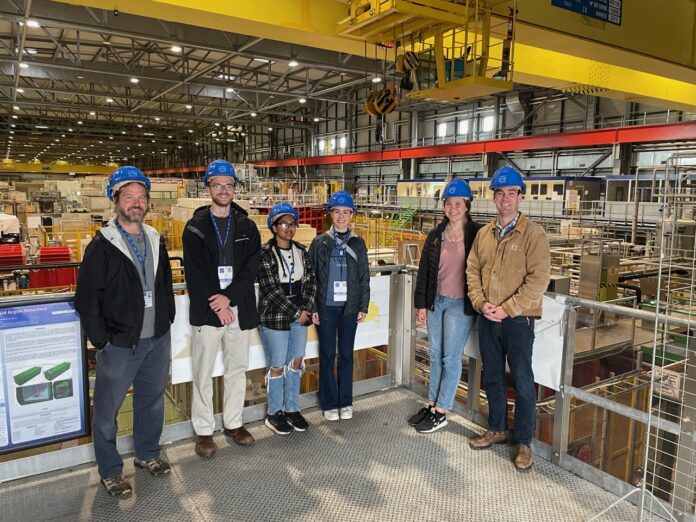
Radioactive isotope experiment excites both neutrons and researchers
After collaborating with other universities on a variety of research projects, the first UD-led project at CERN is now underway under the leadership of Dr. Jacob Moldenhauer, associate professor of physics and chair of the physics department, and Dr. Will Flanagan, affiliate research assistant professor of physics.
The UD physics department has a history of working with CERN, often giving students opportunities to assist in their research. For instance, Genevieve Alpar, junior physics major, worked with Thomas O’Donnell, senior physics major, last summer at CERN to “characterize” different detectors, meaning they determined what energy thresholds they are sensitive to for detecting different particles.
In 2019, researchers from Lawrence Livermore National Labs discovered that the isotope zirconium-88 had a neutron absorption cross-section five orders of magnitude larger than expected. Their results were confirmed by Los Alamos National Labs. The cross-section of an atom is the probability that when you fire a neutron at its nucleus it will “interact with” it – that is, hit it. The predicted cross-section was only 10 barns – a unit of area equal to 1.0×10-28 m2 – but several different experiments have measured a cross-section of over 800,000 barns, an eyebrow-raising difference.
“Your neutrons are hitting your target more often than they were supposed to,” said Moldenhauer, a wry understatement. “We’re going to remeasure this cross-section using a different method, so it becomes a complementary measurement of the cross-section.”
Although various measurements – and potentially the complementary measurements of UD’s research team – have corroborated the cross-section data, there’s a discrepancy in the resonance integral, which is a description of the energy level of a neutron the isotope will interact best with – that is, which energy level it “prefers.” Different experiments have produced irreconcilable results.
“We’re trying to make a measurement to discern which one it is,” said Moldenhauer. “We’re really excited that we are going to be able to measure this resonance or confirm one of the group’s resonances.”
UD’s research team wrote a proposal to test the resonance integral of zirconium-88 and submitted it to n_TOF, the CERN facility that researches neutron-nucleus interactions.
“CERN is the center for nuclear research in Europe and located in Switzerland. It has several different experiments under it,” said Moldenhauer. “Most people only know about the largest one, the Large Hadron Collider (LHC), which has thousands of scientists, but there are actually several other experiments, and n_TOF is one of those – ‘Neutron Time Of Flight.’”
Flanagan was the spokesperson for the proposal’s defense on Wednesday, Feb. 7, and the project was subsequently approved for a 50-day measurement over the summer. In comparison to previous UD experiments, this is an exciting amount of “beam time” – that is, time to use the neutron beam. Typically, UD experiments have only a few days of “beam time.”
Even more excitingly, UD will be using neutrons that are created from protons spun off from the LHC, the largest and most powerful particle accelerator in the world.
There are two spots for UD students to go to CERN to assist with the experiment during the summer, but who will fill them is undecided. In the meantime, the research team will begin test sample measurements, which are preparatory experiments to confirm the results of the researchers’ simulations and gather preliminary data, such as measuring the gamma radiation of yttrium-88.
Zirconium-88 is a radioactive isotope, meaning it decays into more and more stable elements over time. “What zirconium-88 does is it releases this about 400 keV gamma ray, which is pretty gnarly. Then, it decays into yttrium-88, and then into a stable strontium-88,” said Moldenhauer. The half-life of zirconium-88 – that is, the time it takes for half of a given amount to decay into yttrium-88 – is 84 days, giving the researchers limited time with their material.
Because of this, the gamma rays from the yttrium-88 need to be calculated so that they can be distinguished from and subtracted from the results so that only the results from the zirconium-88 are analyzed. In addition, there are also certain gamma rays produced by the radioactive decay of the zirconium that overshadow those emitted from the absorption of the neutrons. Alpar is involved in tackling this issue.
“Right now we’re working on making a 3-D cast for shielding the detector,” said Alpar. This cast, which is made of lead, blocks certain gamma rays – the majority of those produced by the radioactive decay of zirconium-88.
Dr. Dave Catlett, distinguished affiliate professor in the Chemistry Department, and Dr. Said Bakkar, affiliate assistant professor in the Physics Department, are in charge of preparing the zirconium-88 sample.
“Zirconium-88 tends to form a very insoluble salt with chloride. That itself is not soluble, but if you put a whole bunch more chloride in there – like with concentrated HCl – that puts a lot of hydrogen and a lot of chloride ions in there. They tend to compound with the zirconium chloride, and that becomes a charged particle that dissolves in water,” said Catlett. After condensing the zirconium to a residue, the sample will be secured with silicone tape.
Six spring Rome physics majors will join Catlett and Flanagan at CERN on Thursday, March 7, where they will tour several labs around Switzerland until Wednesday, March 13. One of these, Thomas Waterman, a current Spring Romer, will stay at CERN until Sunday, March 17 – the end of his “ten-day” – to assist Flanagan with setting up the test sample measurement.
Flanagan will stay in Switzerland until Tuesday, March 19. Moldenhauer will join him on Monday, March 18 at 6:30 a.m. – testing begins at 8:00 a.m., an hour and a half later, and will end Wednesday, March 20.
Soon the dates for the 50 days of “beam time” during the summer will be set, and UD’s researchers will begin what is hopefully the first of many UD-led research projects at CERN.